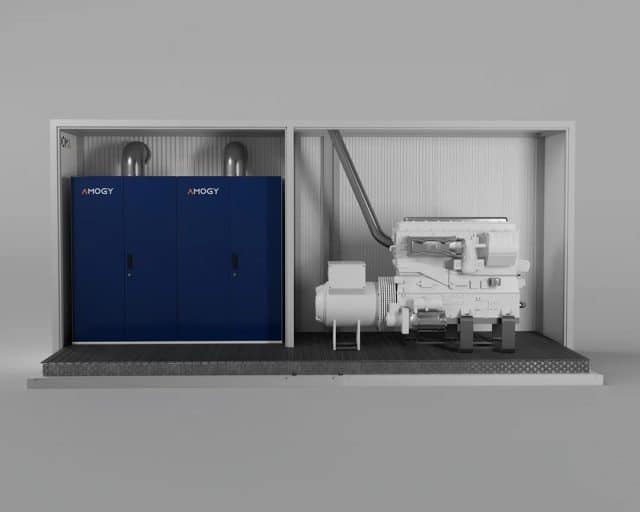Amogy: distributed power generation in South Korea
By Julian Atchison on April 27, 2025
1 MW pilot system to be deployed in Pohang

Click to learn more. Amogy will integrate its proprietary ammonia cracking technology with HDI’s HX22 hydrogen engine, deploying a 1 MW pilot system in Pohang, South Korea. Source: Amogy.
Amogy, GS Engineering & Construction, HD Hyundai Infracore, and the city of Pohang will collaborate to deploy an ammonia-powered distributed power generation system in 2026. The system will combine Amogy’s proprietary ammonia cracking technology with HDI’s HX22 hydrogen engine. Initially deployed as a 1 MW pilot system, the trio already plans to scale up the installation to a commercial, 40 MW system by 2028-29. City authorities will assist with regulatory approvals, related infrastructure development and local partnerships.
This partnership is not only about bringing clean distributed energy to Pohang, but also about establishing a replicable model for energy-resilient cities across Korea and beyond. We’re proud to contribute our ammonia-to-power technology to a project that aligns perfectly with Pohang’s energy ambitions and economic growth strategy.
Seonghoon Woo, CEO of Amogy, in his organisation’s official press release, 22 Apr 2025
By fostering Pohang’s clean ammonia-based carbon-free energy industry as a national future growth engine in South Korea, this partnership will drive innovation in the hydrogen industry centered around the Pohang Hydrogen-Specialized Complex, aiming to make South Korea the world’s leading hydrogen industry powerhouse. We will strongly support the successful deployment of this collaboration, including the support in order to be designated as a Distributed Energy Specialty Complex, under the recent introduction of Distributed Energy Act in South Korea.
Deputy Mayor of Pohang, Jang Sang-gil, in Amogy’s official press release, 22 Apr 2025
Legislated in June 2023, South Korea’s national Distributed Energy Act aims to accelerate the rollout of distributed power generation in the country over the next 5-10 years, including fuel cell and hydrogen-based technology.
JGC, Amogy announce pilot deployment of cracking catalyst
JGC and Amogy will collaborate on the first pilot deployment of Amogy’s “advanced”, low Ruthenium-content cracking catalyst. While Amogy’s focus to date has been on smaller-scale cracking applications and mobility, this demonstration looks towards large-scale hydrogen production from ammonia: a key step in any future ammonia energy supply chain. Indeed, the demonstration is one project in a broader, NEDO-backed initiative to establish competitive hydrogen supply chains into Japan.
Amogy’s portfolio of ammonia cracking catalysts, including both precious-metal-based and base-metal-based formulations, is commercially available through licensing or direct sales.
By 2030, the JGC project aims to enable the large-scale deployment of hydrogen production from ammonia, aligning with Japan’s national strategy to accelerate the adoption of hydrogen as a key energy source.